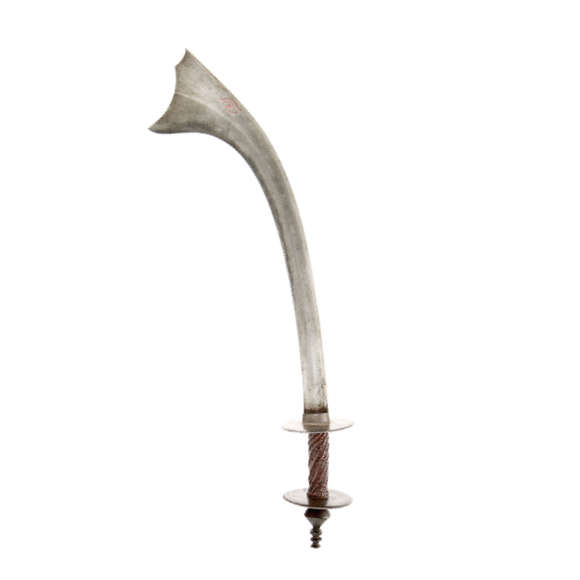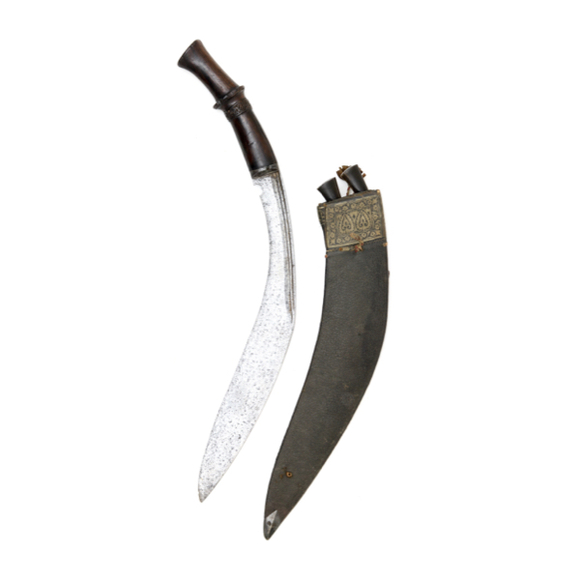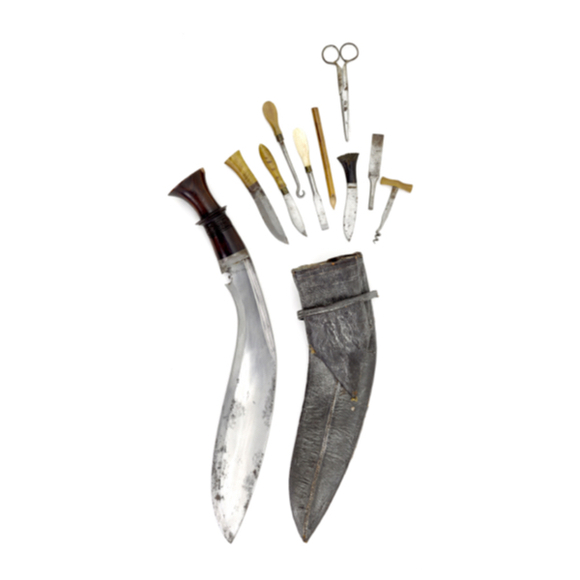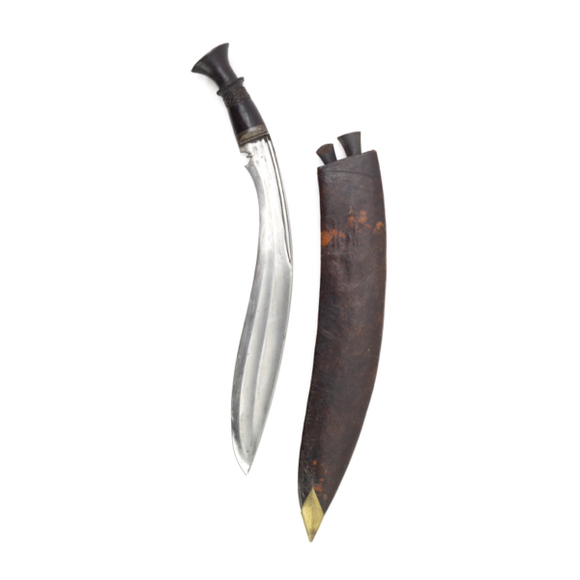Language: Nepali
Source: Kirkpatrick's account of 1793.
Introduction
The Nepalese kōra is a peculiar type of sword that is strongly associated with the Ghurkas of Nepal.
Single-edged, forward curved, and with a pronounced widening at the tip, the kōra looks and feels rather mace-like. They usually have a thick spine to ensure rigidity on the relatively narrow base. Most of the blades are forge-folded with a high-carbon steel edge plate and a wood-like grain. Some kora blades show beautifully complex "bird's eye" pattern welding.
The hilts typically have a cylindrical grip section between two round discs that protect and confine the hand. Pommels are stacked discs, or large bud shapes.
In the literature
British-Gurkha battle of the fort of Kalanga, October 31, 1814:
"The Native troops were still in disarray, and, having but few European officers to keep them steady, they gave the fugitives no support; on the contrary, 1814. sharing in the disorder, and struck with panic, they fled precipitately down the hill, closely chased by the Gorkhas, who inflicted severe loss with their semicircular and heavy swords."
-James Mill and Horace Hayman Wilson;
The history of British India, Vol VIII
J. Madden, London, 1846. Page 34.
British-Gurkha battle of Ryla, April 15, 1815:
"The Gorkhas, lurking behind rocks and bushes, kept up an annoying fire upon the column, but failed to arrest its progress until it had neared the stockade, when a small but resolute body of the enemy rushed suddenly from their lurking-places among the leading files, and, attacking them with their heavy swords, cut down many, and filled the rest with so much terror, that, in spite of the exertions of their officers, they fell back in confusion to the point they had recently quitted."
-James Mill and Horace Hayman Wilson;
The history of British India, Vol VIII
J. Madden, London, 1846. Page 58.
"The Nepalese use a larger knife, or sword "Kora" with an inner cutting edge,
with which those who use it skilfully are enabled to cut a sheep into two with a single blow"
-Lord Wilbraham Egerton
"An Illustrated Handbook of Indian Arms"
W.H. Allen, London. 1880. Page 100.
Etymology
Kōra (कोर) does not turn up in Nepali dictionaries, perhaps because it fell in disuse by the time these dictionaries were written. In Hindi, however, it means "edge, flange, border."
History of the kōra
The basic idea of the kōra is ancient. A number of heavy-tipped, forward-curved weapons appear on the temple reliefs of Borobudur, dating from the 9th century. Although built in Java, the iconography is entirely Indian Hindu.1

Temple relief of Borobudur showing a proto-kōra.
From Sillynewsboy blog.
Heavy-headed weapons and tools that were in common use use by Himalayan hill tribes may have been the inspiration for the extreme widening in the final form of the kōra.2

Various shapes of Himalayan hill tribe weapons.
From Philip S. Rawson; The Indian Sword. Herbert Jenkins, London, 1968. Page 58.
Among antique examples, the kōra appears in mature form already in the 17th century. The Royal Danish Collection has two pieces that have been in the collection since 1674, predating all other known examples by more than a century. Notice the relatively straight and slender shape compared to more recent examples.3

Two Nepalese kōra in the Danish Royal Collection.
They appear in the records from 1674. Accession numbers ECb2 & ECb4.

Koras that were said to date from the battle of Kirtipur during the 1760`s.
Their profiles indeed suggest an 18th-century date on them, with the one just right of the center being significantly older.
Bagbhairab Temple, Kirtipur, Kathmandu, Nepal.
From: atkinson-swords.com
In 1793 Colonel William Kirkpatrick undertook a diplomatic mission into Nepal. In 1811 he published a book with a description of Nepal, with therein a print of a kōra sword and its sheath.4

Khukurī and kōra as depicted in Kirkpatrick's 1811 account of the Kingdom of Nepal.
Based on observations or bringbacks from the 1793 mission.

An antique kōra of the same period.
Mandarin Mansion inventory 2024.
One of the very best kōra in the world is in the Victoria & Albert Museum, London. It was presented by Francis Edward Rawdon-Hastings, 1st Marquess of Hastings, (1754-1826) who served as Governor-General of India from 1813 to 1823. It was presented by him to the East India Company.
It has a noticeably deeper curve and more pronounced widening at the tip, features that would remain characteristic for 19th-century kōra.
 Nepalese kora sword with golden overlaid grooves and dimples.
Nepalese kora sword with golden overlaid grooves and dimples.
Its scabbard with peacock quill embroidery and gold filigree mounts.
Victoria & Albert Museum accession number 2554&A(IS).
It competes for the title "best kōra in known collections" with a piece in the British Royal Collection, RCIN number 61962. It was acquired by Queen Victoria and Prince Albert at an unknown date, but was photographed by Charles Thurston Thompson between 1853-1855.

Early 19th century kōra, photo of 1853-1855.
RCIN number 61962.

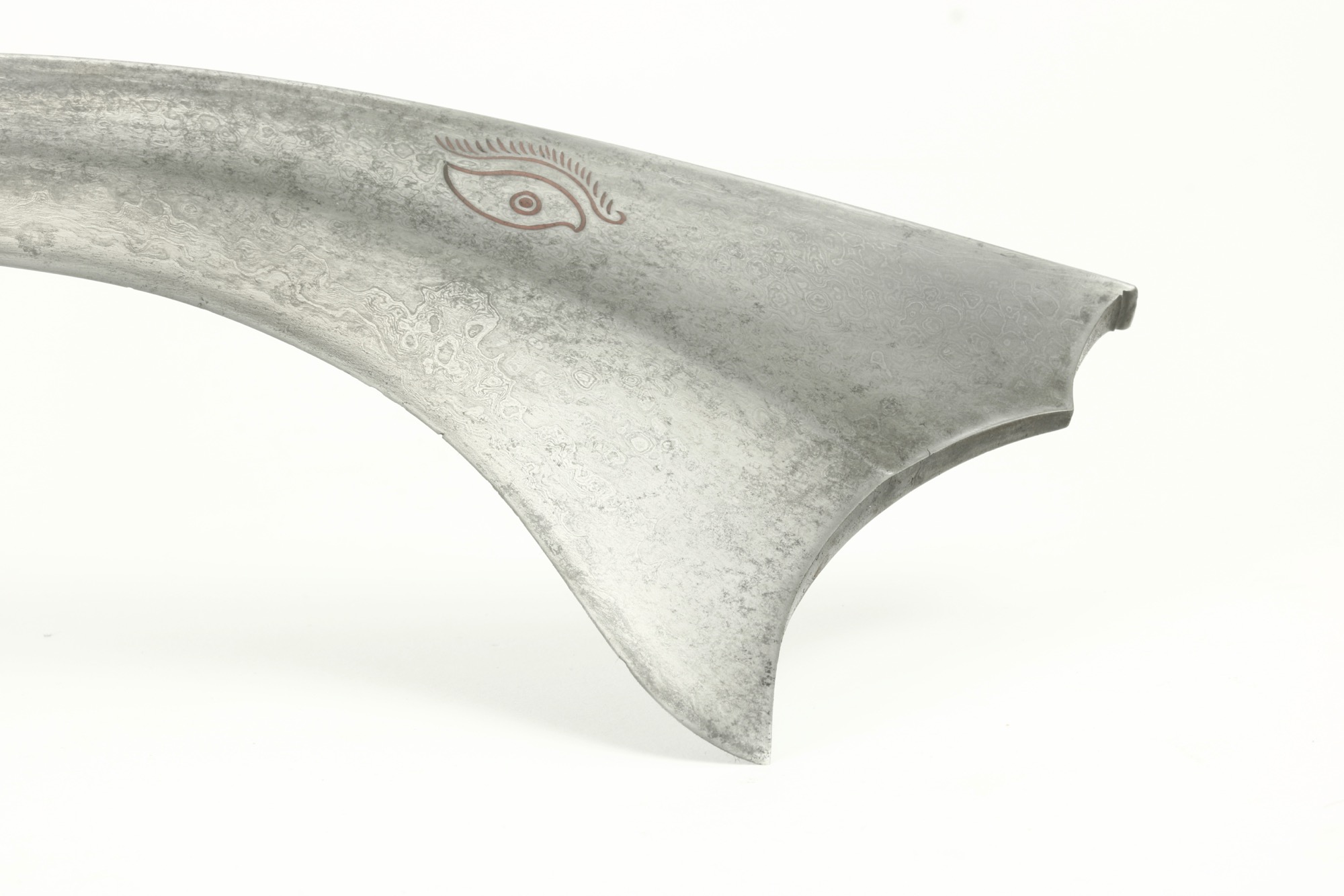

A typical example of the 19th century.
Sold by Mandarin Mansion in 2019.
Notes:
1. P. S. Rawson; The Indian Sword, Herbert Jenkins LTD, London, 1968. Page 32.
2. Ibid. Page 53.
3. Dam-Mikkelsen & Torben LundbÆk. (editors); Etnografiske genstande i Det kongelige danske Kunstkammer 1650-1800, (Ethnographic objects in the Royal Danish Kunstkammer 1650-1800), KØbenhavn, Nationalmuseet, 1980. Object numbers ECb2 & ECb4.
4. William Kirkpatrick; An Account of the Kingdom of Nepaul; being, The Substance of Observations made during a Mission to that Country in the Year 1793. William Miller, London, 1811.

